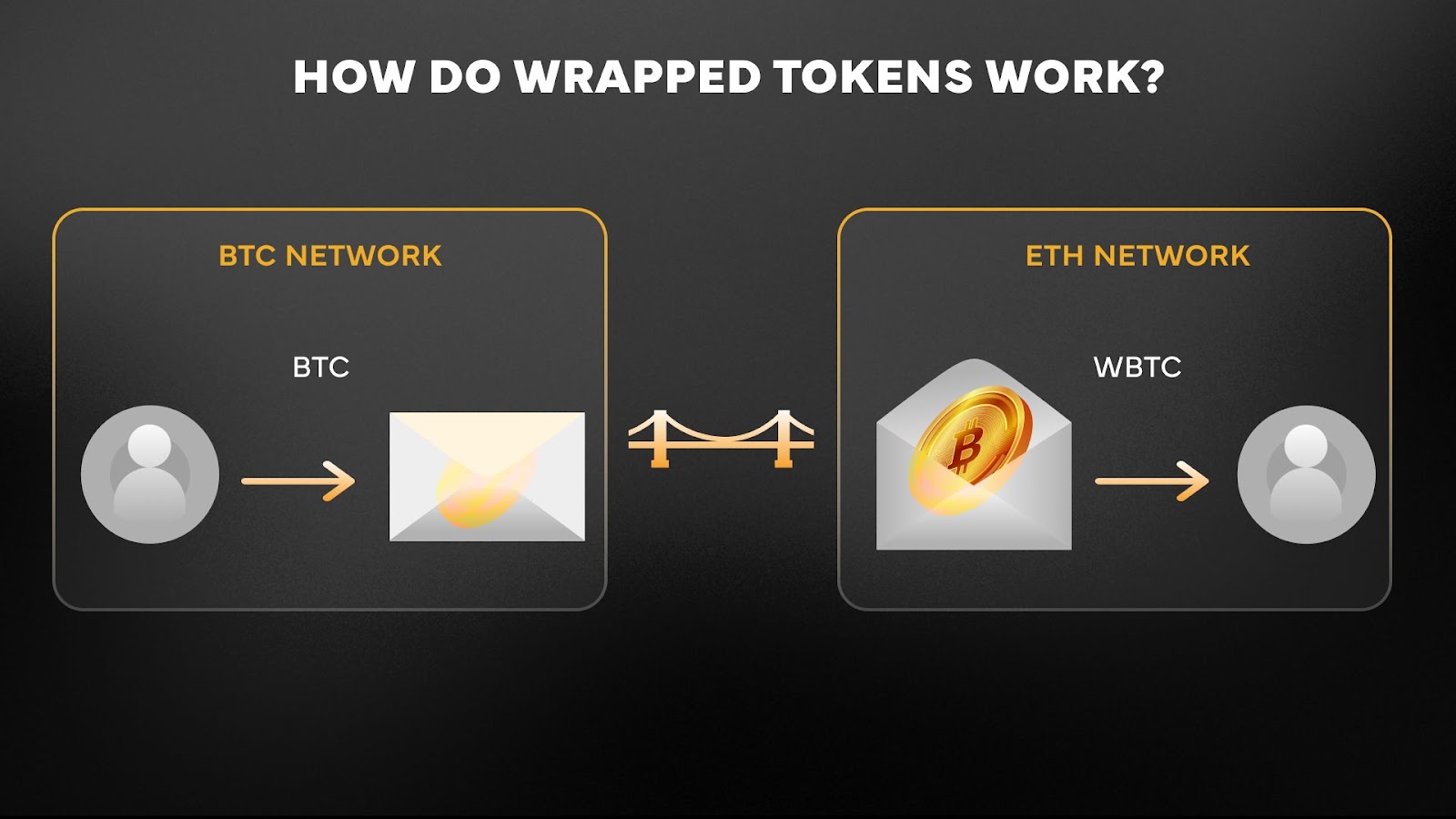Bitcoin
Bitcoin CPI
Venture Portfolio
Funds
Market Insights
Indicators
About
Contact

February 22, 2025





One of the greatest growth opportunities for blockchain is to increase interoperability among these diverse ecosystems.
An already working solution to this is so-called wrapped tokens. They allow you to use your crypto assets in more than one blockchain, bringing you new opportunities and helping blockchain ecosystems grow as well.
In this guide, you’ll learn about the concept of wrapped tokens in more detail, how they work, and what their benefits and drawbacks are.
Wrapped tokens are blockchain-based assets that represent a specific crypto asset. They allow you to indirectly use your crypto asset in another blockchain ecosystem.
A wrapped token is backed 1:1 by the original asset, which means that for every wrapped token, there’s an equivalent amount of the original asset held in reserve by a custodian or smart contract.
For example, Wrapped Bitcoin (WBTC) is an ERC-20 token that is a wrapped version of Bitcoin (BTC). It can be used within the Ethereum ecosystem for DeFi activities such as trading, lending, and providing liquidity. There are other versions of WBTC that can be used on other blockchains, including Base.
The market of wrapped crypto assets is diverse and keeps growing, providing you with opportunities to use your assets in a much broader world of blockchains.

There are various approaches to how a wrapped token is created, as they differ in the level of complexity, decentralization, and security. However, the main concepts of this process are usually the same.
Let’s walk through all the main components of creating and redeeming a wrapped token.
A custodian, such as a centralized entity or a smart contract, holds the original asset in reserve. For example, BitGo, the issuer of WBTC, also takes care of the custody of BTC that is deposited before wrapping it.
When a user wants to obtain a wrapped token they deposit the original asset (e.g., BTC) with the wrapping platform. Then, depending on the solution, the whole process starts, including the custodian minting the corresponding amount of wrapped tokens (e.g., WBTC) on the target blockchain.
The wrapped token that is deposited to your wallet can now be used on the target blockchain for activities such as trading, staking, or other DeFi instruments in the same way as you would use any other crypto asset.
When you want to convert your wrapped tokens back into the original asset, then the custodian burns the wrapped tokens and releases the equivalent amount of the original asset to your wallet.

The market of wrapped crypto tokens keeps growing alongside the broader crypto asset industry and is now worth tens of billions of USD. Here are some of the leading tokens.
Wrapped Bitcoin is the most popular and biggest wrapped token in terms of market cap. While it’s available on several blockchains, the most popular version is the ERC-20 token that allows you to use your BTC in the Ethereum ecosystem.
WBTC was launched in 2019 by BitGo in partnership with Kyber Network and Ren. Each WBTC is backed 1:1 by Bitcoin held in reserve by custodians.
WBTC is commonly used in decentralized exchanges, lending platforms, and yield farming protocols. For example, it allows Bitcoin holders to earn interest by lending WBTC through DeFi protocols like Aave or Compound.
The dominance of WBTC is constantly being challenged by new entrants to the market, such as Coinbase’s cbBTC.
Wrapped Ether (WETH) is a tokenized version of Ethereum's native cryptocurrency, Ether (ETH), that is designed to be compatible with Ethereum's ERC-20 token standard.
ETH was born before the ERC-20 standard, which is now the most popular in the Ethereum ecosystem, therefore, wrapping ETH increases the usability of this crypto asset.
You can wrap ETH, for example, on decentralized exchanges, such as Uniswap, and use it for trading, lending, providing liquidity, or using other DeFi opportunities. WETH can also be easily unwrapped back into ETH.
Blockchains such as BNB Chain, Polygon, and Avalanche also have their own versions of WETH.
Besides WBTC and WETH, you can find many other versions of wrapped BTC and ETH, depending on your needs and technical knowledge. Some of these are more decentralized than others, such as dlcBTC and sBTC.
However, Bitcoin and Ether are not the only crypto assets you can wrap. Here are more:

The growing adoption of wrapped tokens is driven by the many advantages they bring to blockchain ecosystems. At the same time, these benefits come with challenges that need to be carefully managed.
Let’s take a closer look at the pros and cons of wrapped tokens.
Some of the advantages that wrapped tokens offer are as follows:
The main advantage is that wrapped tokens allow assets from one blockchain to be used on another blockchain. This increases their interoperability and their use cases. Thanks to this interoperability, wrapped tokens bring more benefits as described below.
These tokens allow you to access a more diverse DeFi ecosystem across multiple blockchains, which creates additional opportunities for you when it comes to lending, borrowing, and staking your crypto assets.
By getting assets like BTC to indirectly operate on Ethereum, wrapped tokens create greater liquidity for decentralized exchanges and protocols.
Wrapped tokens also create opportunities for yield generation and efficient capital allocation.
Some of the challenges and risks that wrapped tokens face are as follows:
Many wrapped token systems rely on custodians, which introduces a degree of centralization and requires trust in third parties.
The reserves backing wrapped tokens must be securely managed and any breach or mismanagement could result in loss of funds.
Any vulnerabilities in smart contracts can lead to exploits and financial losses. Constant smart contract audits can help decrease these risks.
The wrapping and unwrapping process can be complicated for non-technical users and can also lead to human errors and financial losses.
Wrapped tokens play a very important role in increasing the interoperability among blockchains, which means that you can use your crypto assets in more diverse ecosystems while helping them grow.
Thanks to wrapped tokens, you can access more decentralized applications (dApps) and participate in more DeFi platforms without being restricted by the limitations of their native blockchains.
Therefore, bridging liquidity across blockchains and creating wrapped tokens can help build a diverse decentralized ecosystem from which investors can benefit.
While wrapped tokens aren’t the only interoperability solution in town, they will likely continue to play an integral role in bridging blockchain ecosystems–all to the benefit of users and investors.
The market will likely see even more wrapped tokens joining the ring, as evidenced by recent announcements by exchanges such as Coinbase and Kraken, while developers will keep improving this solution to make it safer, for example, by increasing decentralization.
Disclaimer: The content of this blog post is not investment advice and does not constitute any offer or solicitation to offer or recommendation of any investment product.
A token is "wrapped" by depositing the original crypto asset, such as BTC, with a custodian who mints an equivalent amount of wrapped tokens on the target blockchain, for example, Ethereum. The wrapped token can then be used on a different blockchain while the original asset remains locked in reserve.
Wrapped tokens are usually considered to be safe, as they’re backed by the original crypto asset that is held by a trusted custodian or a smart contract. However, they are subject to risks such as custodial mismanagement and smart contract vulnerabilities. Regular audits, transparent protocols, and decentralized custody solutions can help mitigate these risks but users should be aware of the risks.
Wrapped tokens are pegged to crypto assets, while stablecoins are usually pegged to fiat currencies or commodities. For example, WBTC is pegged to BTC while USDT is pegged to the US Dollar. The price of a wrapped token depends on the price of the underlying crypto asset and will fluctuate accordingly.
Some of the risks include reliance on custodians or other centralization-related risks, while smart contract vulnerabilities can become a threat. Additionally, wrapping some cryptoassets might require more technical knowledge which increases the risk of human error.
Yes, wrapped tokens can be traded on decentralized and centralized exchanges. They can be held long-term as they maintain a 1:1 value peg to the underlying asset. However, to hold the asset long term requires trusting the custodian and the protocol that manages the reserve backing the wrapped token.